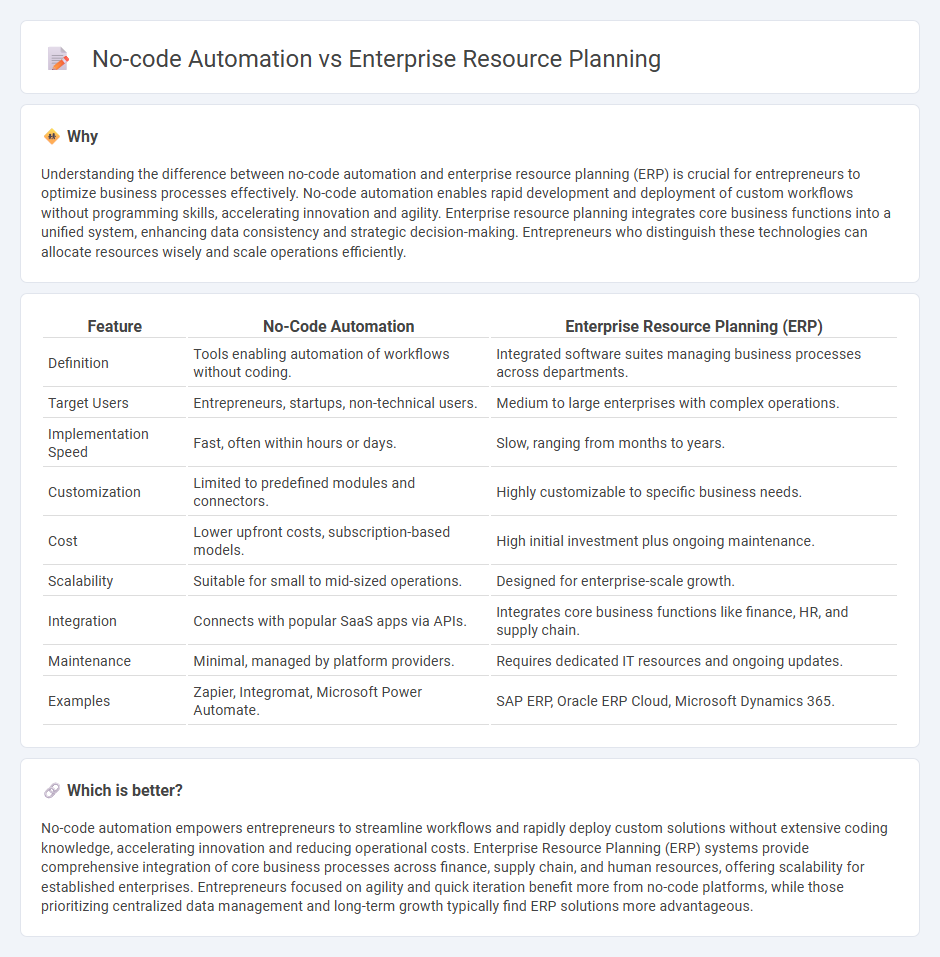
No-code automation empowers entrepreneurs to streamline business processes without coding expertise, enabling rapid customization and agile workflows that adapt to changing market demands. Enterprise Resource Planning (ERP) systems integrate core business functions into a unified platform, offering comprehensive data analytics and resource management essential for scaling operations. Explore how leveraging no-code automation alongside ERP solutions can revolutionize your entrepreneurial strategy and drive growth.
Why it is important
Understanding the difference between no-code automation and enterprise resource planning (ERP) is crucial for entrepreneurs to optimize business processes effectively. No-code automation enables rapid development and deployment of custom workflows without programming skills, accelerating innovation and agility. Enterprise resource planning integrates core business functions into a unified system, enhancing data consistency and strategic decision-making. Entrepreneurs who distinguish these technologies can allocate resources wisely and scale operations efficiently.
Comparison Table
| Feature | No-Code Automation | Enterprise Resource Planning (ERP) |
|---|---|---|
| Definition | Tools enabling automation of workflows without coding. | Integrated software suites managing business processes across departments. |
| Target Users | Entrepreneurs, startups, non-technical users. | Medium to large enterprises with complex operations. |
| Implementation Speed | Fast, often within hours or days. | Slow, ranging from months to years. |
| Customization | Limited to predefined modules and connectors. | Highly customizable to specific business needs. |
| Cost | Lower upfront costs, subscription-based models. | High initial investment plus ongoing maintenance. |
| Scalability | Suitable for small to mid-sized operations. | Designed for enterprise-scale growth. |
| Integration | Connects with popular SaaS apps via APIs. | Integrates core business functions like finance, HR, and supply chain. |
| Maintenance | Minimal, managed by platform providers. | Requires dedicated IT resources and ongoing updates. |
| Examples | Zapier, Integromat, Microsoft Power Automate. | SAP ERP, Oracle ERP Cloud, Microsoft Dynamics 365. |
Which is better?
No-code automation empowers entrepreneurs to streamline workflows and rapidly deploy custom solutions without extensive coding knowledge, accelerating innovation and reducing operational costs. Enterprise Resource Planning (ERP) systems provide comprehensive integration of core business processes across finance, supply chain, and human resources, offering scalability for established enterprises. Entrepreneurs focused on agility and quick iteration benefit more from no-code platforms, while those prioritizing centralized data management and long-term growth typically find ERP solutions more advantageous.
Connection
No-code automation platforms streamline enterprise resource planning (ERP) by enabling entrepreneurs to customize workflows without extensive coding, reducing implementation time and costs. This integration enhances data accuracy and operational efficiency by automating routine tasks and synchronizing information across departments. Leveraging no-code tools within ERP systems accelerates digital transformation, empowering startups and enterprises to scale operations with agility and minimal technical barriers.
Key Terms
**Enterprise Resource Planning:**
Enterprise Resource Planning (ERP) integrates core business processes such as finance, supply chain, and human resources into a unified system, enhancing operational efficiency and data accuracy. Popular ERP solutions like SAP, Oracle, and Microsoft Dynamics offer customizable modules tailored for various industries, supporting real-time analytics and compliance management. Discover how ERP can revolutionize your business workflows and drive sustainable growth.
Integration
Enterprise Resource Planning (ERP) systems offer comprehensive integration by centralizing data and processes across finance, supply chain, and human resources, ensuring seamless workflow and real-time analytics. No-code automation platforms emphasize flexible, user-friendly integration with various applications and APIs, enabling rapid automation without extensive coding. Explore how each solution enhances operational efficiency through integration to determine the best fit for your business needs.
Centralized Database
Enterprise Resource Planning (ERP) systems integrate various business processes into a centralized database, ensuring seamless data consistency and real-time accessibility across departments. No-code automation platforms offer flexible workflows but often lack the robust centralized data management inherent to ERP solutions, potentially leading to data silos. Explore how centralized databases transform operational efficiency by integrating complex data streams in ERP versus no-code tools.
Source and External Links
Enterprise resource planning - ERP is integrated management of main business processes in real time, using software to collect, store, manage, and interpret data from various departments to enhance organizational efficiency.
What Is ERP? - ERP is software that manages day-to-day business activities like accounting, procurement, project management, and supply chain, providing a unified system that links multiple business processes and data sources.
What is ERP? A Comprehensive Guide - ERP systems automate business processes and centralize data from multiple departments, enabling efficient analysis and decision-making while unifying finance, manufacturing, inventory, sales, and HR in one platform.
 dowidth.com
dowidth.com